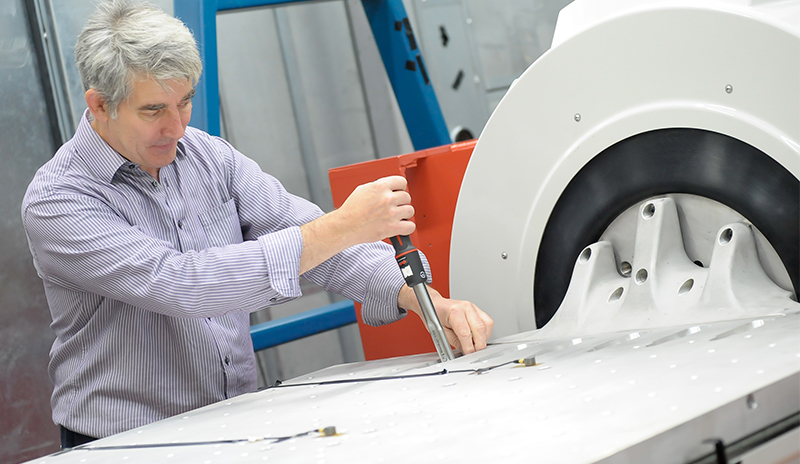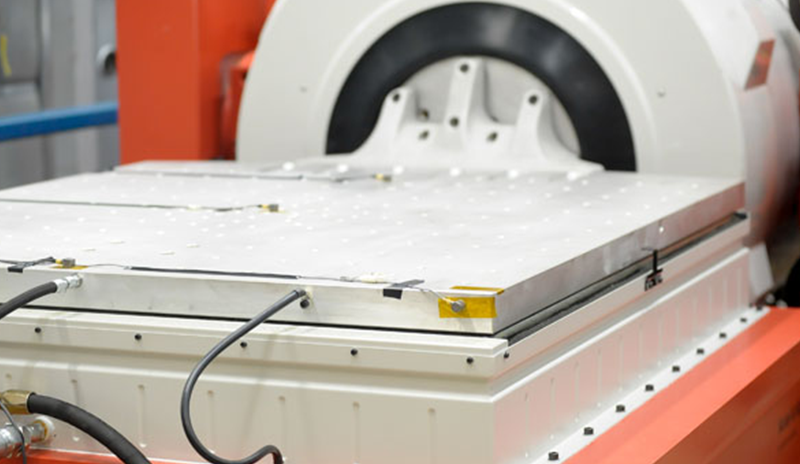The article is based on HBK LDS’ many years of experience in the world of vibration, and the plethora of problems that can be encountered during the vibration testing of components and assemblies. This time we look at shaker operation including:
- Test Design and Operations
- Loads and Fixtures
- Large Payloads
- Slip Tables
Test Design and Operations
Test dynamics
The combined dynamics of the item under test, fixtures and shaker armature should be well understood, especially where the payload is large, or the test is severe.
Test frequencies
The shaker should only be run within both its maximum and minimum frequencies.
Accelerometers
It is recommended to ensure that all accelerometers are rigidly mounted and will not fall off during the test.
Cross-axial motion
Careful monitoring of the cross-axial motion is advised to avoid exceeding shaker overturning moment capability.
Users of equipment
Only trained personnel should use the equipment. If training is required, then contact HBK LDS for details of courses in vibration testing.
Equipment manual
Users should familiarize themselves with the equipment manuals including any special addenda.
Before test checks
Do ensure that the shaker and other equipment are working correctly before starting tests.
Test failure
Any failure should be recorded, and efforts made to analyse the cause before repeating the test. Doing so will avoid repeated failures caused by the same problem. Where appropriate, pass details of failures to the HBK LDS engineering team including drive and profile plots.
Fixed frequency test
The shaker may not run at full performance during fixed frequency tests, as frequencies may coincide with shaker resonances. This may cause failure to achieve the desired test level and/or damage to the shaker.
System characterization
To determine the correct control positions for the tests to be run, the system should be characterized by running low-level sine sweeps; characterization plots can be kept for future reference.
Shaker specification
The vibration test system and other related equipment should only be run within specification, as detailed in the user manuals.
Test masses
The exact mass of the payload and fixture should be known before starting the test. This will avoid overdriving the shaker.
Loads and Fixtures

Suitability for purpose
It is essential to ensure that fixtures are suitable for the purpose required of them.
Thermal expansion
LEARN MORE
LDS THERMAL BARRIERS
All jig design should take account of the effects of thermal expansion. Different materials when fastened together and subjected to changes in temperature will induce stress in the components. Slip tables in thermal chambers are particularly susceptible to thermal expansion whereby bearings can be damaged, particularly if the jig bolts are tightened before the slip plate has reached the working temperature of the chamber.
Torque settings
Inserts and payload bolts should always be tightened to the correct torques as defined in the user manuals. Over tightening these bolts can cause damage to the inserts, under tightening can cause the payload to rattle or work loose resulting in inaccurate measurements being made or damage to the system, or payload.
Load support
Always use the load support system as described in the user manuals.
ACCELEROMETER VIBRATION SENSORS
Accelerometer positioning
Accelerometer positions should be chosen with great care; control accelerometers must not be positioned at vibration nodes. In some cases, this could cause the armature to be become damaged.
Fixing the load
It is recommended to use as many fixing points as possible when attaching a fixture or payload using short fixing bolts rather than long ones, which may resonate during the test.
Overturning moments
The shaker can be damaged by payloads that are unstable or mounted in ways that exceed the shaker’s overturning moment capabilities. Accelerometers can be used to limit the overturning moment applied to the system.
Payload dimensions
For payloads wider than the diameter of the shaker armature, a head expander or extender should be used.
Large payloads
Availability of services
Where the type of payload to be tested is unusually large (in the order of tonnes and metres), then the type of installation that is best, depends on the budget available and the exact test requirements. HBK LDS is pleased to offer suggestions based on the detailed test specifications supplied. Tall payloads impose high overturning moments on the armature guidance and shaker support structure.
LDS has considerable experience of supplying systems featuring:
- Large head expanders, slip tables (up to 3 m square) and combo systems
- Large shakers in both Lin-E-Air and solid trunnion configurations
- Seismic block mounting (see ‘Shaker and slip table’ later in this paper)
LDS Slip Vibration Shaker Tables
LEARN MORE
SHAKER EQUIPMENT
HBT / LPT SLIP TABLES
Connecting the Mating Surfaces
Any mating surfaces should be correctly connected, with no fretting of the surfaces. Surfaces should be flat and smooth, and bolted together using short bolts at close spacings. Where a drive connection is fitted to the armature, it is recommended to ensure that all inserts are used, and the structure is dynamically rigid to the highest drive frequency.
Design of the jigs and fixtures
Design of jigs should consider the following information:
- Do not exceed the slip plate overturning moment given in the user manual, as this will cause damage to the bearings.
- Try to cover all available bearings as this will give the best overturning moment restraint.
- Keep in mind that the slip plate is only stiff in the three axes, but flexible in the three rotations. Jigs should be designed to add to the stiffness of the slip plate.
Attaching jigs and fixtures
Flatness of jigs and fixtures is critical. Uneven or bowed jigs can cause binding of the bearings within the slip plate and rubbing of the slip plate against the granite table base. Fixing bolts should have a length as specified in the user manuals. Bolts that are too long will damage the slip plate; bolts that are too short may not fully engage in the insert.
Thermal expansion
Jig design should take account of the effects of thermal expansion. Different materials, when fastened together and subjected to changes in temperature, will induce stress in the components. Slip tables in thermal chambers are particularly susceptible, whereby the bearings can be damaged if jig bolts are tightened before the slip plate has reached the working temperature of the chamber.
Armature connection
Where possible, all armature inserts should be used to attach driver bars or fixtures. Using only a few can cause the inserts to pull out, or the dynamics of the armature to change.
Related Products



